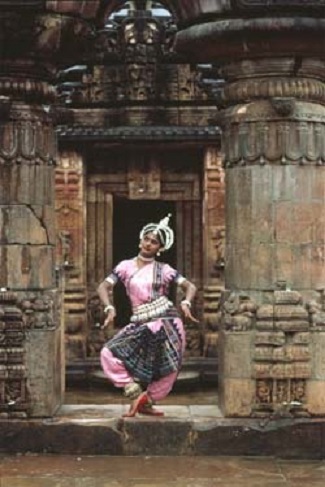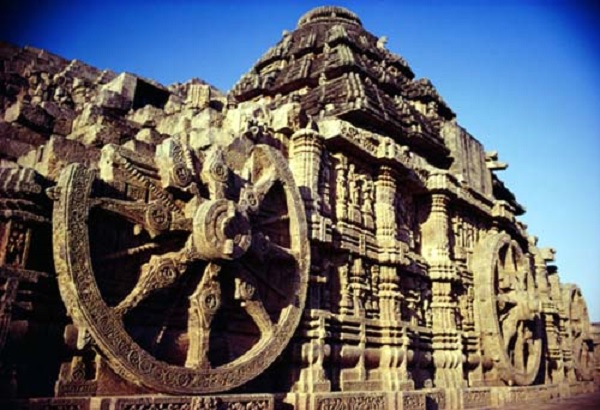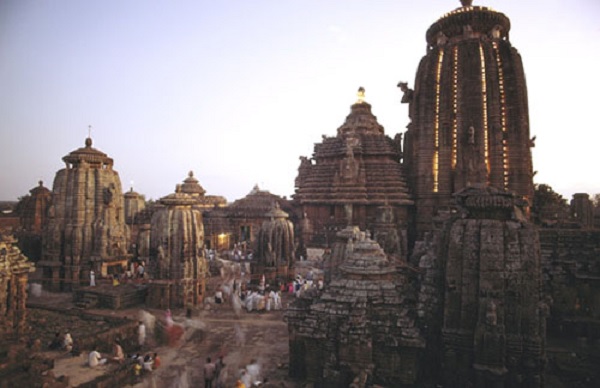Dec 09, 2025
Dec 09, 2025
by Aniket Kumar
Glorious Symbols of Art, Architecture and Culture
 Orissa's history dates back to the days of the Mahabharata. It was under the rule of the Nanda Kings in the pre Christian era and then under the Mauryan rule. Rock edicts of Emperor Ashoka are found in the State. The impact of the invasion of the Guptas is seen in the early temples of Bhubaneswar. The Matharas ruled Orissa from the later half of the 4th century AD. The Sailodbhavas who followed constucted several shrines the ruins of which can be seen today. (600-750 AD).
Orissa's history dates back to the days of the Mahabharata. It was under the rule of the Nanda Kings in the pre Christian era and then under the Mauryan rule. Rock edicts of Emperor Ashoka are found in the State. The impact of the invasion of the Guptas is seen in the early temples of Bhubaneswar. The Matharas ruled Orissa from the later half of the 4th century AD. The Sailodbhavas who followed constucted several shrines the ruins of which can be seen today. (600-750 AD).
The period of the Bhaumakaras and Somavamsis (8th to 11th centuries AD) played a major role in the cultural life of the State. Saivism dominated the religious scene although Budhist, Jain and Vaishnavite monuments also came into being.
The Gangas took over after the decline of the Somavamsis. The early Eastern Gangas ruled from Kalinganagara (Mukhalingam near Srikakulam Andhrapradesh). They shifted their capital to Cuttack in the 12th century. Saivism began to decline while Saktism flourished.
Further, the religious leader Ramanujacharya had a great influence on the monarch Chodagangadeva who built the great temple at Puri. The Gangas were champions of Vaishnavism. It was during the Ganga rule that Orissan architecture reached its peak. Narasimhadeva of this dynasty built the Sun Temple at Konark.
The Gangas were succeeded by the Suryavamsi Gajapati rulers, under whom Vaishnavism in the form of Jagannatha worship reached new heights. This period was marked by the influence of Chaitanya Mahaprabhu and by the construction of Jagannatha temples across the length and breadth of the empire.
After the decline of the Gajapatis, the kingdom began to disintegrate and was taken over by followed by Muslim rule, the rule of the Mughals, the Mahrattas and then the British. The Bhoi Gajapatis who ruled Orissa over a small territory caused several Jagannatha temples to come up.
Jagannath Temple : (Puri)
This temple was constructed at about last part of 11th century or first part of 12th century as per the version of historians. It is the earlist Ganga monument of Orissa, but it must be noted that the ganga temples of much earlier dates are still to traced in the Andra regions, the original seat of power of Gangas. There is a definite mention in all the later copper plate records of the successor of Chodaganga that he was the builder of this great temple at Puri. According to some evidence sources that Chodaganga had began this huge structure and one his successor Ananagabhimadev III completed it or added the Jagamohan to it. The height of the Jagannath temple of Puri as calculated as 215 feet 8 inches. It is therefore the loftiest religious edifice of Orissa. At present the thick coat of plaster which had covered the structure for centuries has been removed and the stone works on it are now, proof of the sculptural richness of that era.
As is usual in all great temples of the period, the monument stands on a high platform which is connected with the ground level by a height of 22 very very big steps. The edifies is massive and strong and is a product of accumulated experience of the past in temple architecture and this factor has enabled it to with stand the ravages of time.

The Sun temple at Konark is the grandest achievement of the eastern school of architecture, is situated some 20 miles in a north-easterly direction from Puri. Grand in conception and great even in its ruin, the stupendous undertaking stands with its disfigured beauty in a desolate track of ever- drifting sands of Chandravaga. It is said that, the very first ray of the Sun very morning falls upon this temple, from which it got its name. It is believed that the Lord Sun (Surya) was worshiped here.
The Orissan devotional architecture which made an humble beginning in the 2nd century B.C. had a history of 1500 years when the temple at Konark came into being. In shape the temple however did not make any bold departure from other Sikhar temples of Orissa. The main temple which enshrined the presiding deity has fallen off, but what remains at present enables us to reconstruct the whole. The doorway of the structure which was to the east has been blocked up giving the cella the appearance of a well. As a visitor stand facing the east, his attention is drawn to a step-like masonry which was a so called corbelled arch usually found above the doorway of a temple and was meant to reduce weight on the linted. The total height of the temple was 227 feet. The joint structure of the Vimana and Jagamohana were conceived in the form of a Chariot (Ratha) and have therefore been based on an immense terrace with 24 giant wheels, being as it were, dragged on by seven richly caparisoned Steed. Each part of the temple proclaims its correct architectural application and the whole is assembled in such a masterly manner that the result is an ordained and convincing uniformity.
Sarala of Jhankad
The place is famous for goddess Sarala, the supreme divinity of learning. A large body of pilgrims visit JHANKAD on festive days. Sarala has legendary link with Parsurama, the son of Yamadagni for which Jhankad has gained the historical importance as a centre of Parasurama cult. Tradition says that Parasurama, the sixth incarnation of lord Vishnu engraved the deity by his arrow and worshipped her for knowledge & power. Jhankad is associated with the life of first most celebrated epic Oriya poet Sarala Das, of 15th century A.D.
Panchalingeswhar
Panchalingeshwar is situated on a hillock near Nillagiri surrounded by green forest. A perennial stream flows on the five Lingams. Epigraphy & also the tradition says that this was the capital of King Banasura & the five Lingums known as PANCHLINGESWAR were installed by the same king. This is a place of beautiful surrounding. It serves as a picnic spot for the visitors.
Akhandalamani Temple
A beauty spot on the bank of river Vaitarani, the sacred Ganges of Orissa. Aradi is famous for the shrine of Akhandalamani. Its is around 45 Kms from Bhadrak. Everyday hundreds of pilgrims visit Aradi to worship Lord Siva.
Charchika Banki
The holy shrine of Charchika is located on a hill top on the bank of river Mahanadi which is around 40 Kms from Bhubaneswar. The main attraction of this plastered temple is the wooden carvings of the Hall of Audience are of excellent craftsmanship. The presiding deity, the eigth armed image of goddess CHAMUNDA sitting over a prostrated body is worshipped according to Tantric rites (Witch Craft) .
Dhavaleswar
A small but enchanting island in Mahanadi, Dhabaleswar attracts the pilgrims all with the spell of the river. The temple lord Dhavaleswaris situated on a hilllock and approached by two flights of steps - one from the north and another from the south. It is around 35 Kms from Bhubaneswar. Dhavaleswar is approachable from Chahata Ghat. Though the temple is a new one, yet sculptures of 11th century A.D. are found in the temple premises. One among them is the marriage procession of Siva with his vehicle Nandi.
Baladevjew
It is known to the pilgrims as "Tulasi Kshetra",Kendrapada houses the temple of lord Baladev. The rites and rituals of lord Jagannath at Puri are generally followed here which made Kendrapara equally attractive. It is situated nearly 90 Kms from Bhubaneswar.
Leaning Temple
Huma, 35 Kms from Sambalpur is adorned with a leaning temple dedicated to lord Bimaleswar. On the river Mahanadi, it is a scenic beauty spot of great excellence. The Kudo-Fishes here are believed to belong to lord Siva and they are very friendly to visitors.
Vaidyanath
The place is about 8 miles from Sonepur in the Bolangir district. The temple of Kusaleswar standing in ruined condition is a most remarkable monument.There is also another temple known as KALESWAR standing on the river Tel.
Kapilas
The Kapilas hill range which roughly from the boundary of Cuttack & Dhenkanal districts consists of numerous peaks. The loftiest among them, is called "KAPILAS" 682 metres. Below this peak is located the famed temple of Lord Siva for which it is identified with "KAPILAS" the magnificent abode of Siva. The temple is situated at a height of 454.5 metres and a zigzag good motor-able path leads to the temple. Tourists cherish a great regard for the esteemed sanctity of the shrine. The temple of Lord Siva, Chandrashekhar, dominates the landscape for kilometres around. In front of the main temple of 18.18 metres high, stands the pillared constructions of the Hall of Audience and Hall of Offering with fine wood carvings inside. A flight of 1300 steps and also a great road lead to the temple. To the east of the main temple, hoists the temple of Narayana and Vishwanath. It is believed that the main temple may be ascribed to Narasimhadev II of Ganga dynasty who completed it during early part of the 14th century.
Nilamadhava Temple
It is situated on the right-bank of the river Mahanadi, in Khandapara of Puri district, stands the famous temple, which is believed to have been worshipped by the Tribals. It is believed that it has been constructed and worshipped earlier than the construction of lord Jagannath temple at Puri. Therefore, this holy land claims priority over Srikshetra (Puri) and, another attraction of this place is Singhanath Temple.
Lingaraj Temple

The temple of Lingaraj by far the most notable temple not only of Bhubaneswar but also of Orissa, and according to expert opinions is also one of the best archaeological monuments of the East. Rising to a height of about 180 feet and dominating the entire landscape within an area of about 10 miles, this great temple represents the quintessence of the Kalinga type of architecture and the culminating result of the architectural activities at Bhubaneswar. Its stands in the midst of a number of smaller temples within a spacious compound of laterite measuring 520 feet in length and 465 feet in breadth and having gates on the east, north & south.
Rajarani Temple
Although the Rajarani temple has been one of the most notable monuments of the place, such a name does not occur in any of the four Sanskrit texts that profess to deal with the history of Bhubaneswar from the orthodox standpoint.
The names of all Saiva temples at Bhubaneswar ends with Eshwar, e.g. Parsurameswar, Brameswar, Mitreswar, Yameswar etc. The names of non-Saiva temples have been derived from their presiding deities, e.g., Gauri temple, Parvati temple, Mohini temple and Ananta-Vasudev temple etc.
Brahmeswar Temple
The next dated temple, Brahmeswar, shows mature workmanship and advanced architectural features. Here the canons of Orissan architecture is found to have been fully applied. Among the dated temples it is the earliest one where iron beams have been used, and where porch or the Jagamohana consists of the full-fledged Pidha-Deula with the usual crowinging members. It is a pancha-ratha temple with five plasters, namely two corner plasters, two intermediate ones & one central one, fully developed which give the structure almost a rounded appearance.
Swarnajaleswar Temple
It stands on the road from the Lingaraj to the Kedargouri temple and was in a utterly ruined condition, but the structure is being restored now. The evidences that connect with the Parsurameswar are that the cult images in both have attributes and that both possess close architectural affinities. It bears on the lintel of its northern niche a scene of Lord Siva's marriage, which can be regarded as a replica of the same scene carved on the lintel of the eastern niche of the Parsurameswar. The Swarnajaleswar like all the early temples also bears several scenes from Ramayana & The Mahabharata in a sunken panel running round the Vimana and making the transition between the Vada and the Sikhara.
Yogini Temple
On the outskirts of Bhubaneswar is Hirapur village with its Hypatheral temple of sixty-four Yoginis.One among them the two such distinguished temples in Orissa and four such in India,it has beautiful Yogini images -a great study for the connoisseurs of art & architecture. The second one is located at Ranipur-Jharial with a plethora of others temple.
Sari Deul Temple
It is situated just behind the Jagannath Ballabh Matha on the southern side of Vindu Sarover. The temple both in dimension and workmanship is in no way inferior to that of Ananta-Vasudev, but with houses surrounding it on all sides,it is now relegated to an obscure corner. It is a typical example of a Sapta-Ratha temple and its art & architecture provide ample evidence to indicate that it belonged to the Ganga period. The pilasters have been over crowded with numerous scrolls containing the favorite designs of the Ganga art.
Satrughaneswar Temple
This temple belongs to the 6th century A.D. group of temples. Even the earliest extant temple, the Satrughaneswar, is found to be a mature conception and origin of the monument apparently lie further back. It represents a Sikhara temple and its shape as available now after restoration and a few sculptures that still exists on the monument or have been recovered from it, supply affinities with those of the Dasavatara temple at Deogarh. The sculptures of the Satruganeswar are marked by the vigor & exuberance of the designs recalling the best characteristics of the Post-Gupta Art. The ruined temple of Laxmaneswar standing by its side appears to be a closely analogous monument in shape as well as from and it seems to be an immediate successor of the Satrughaneswar.
Sureswar & Gouri Temple
There are two other temples at Bhubaneswar, which may be regarded as close contemporaries of the Mukteshwar temple. One of them is the Sureswar, a very small structure which stands near the Kotitirtheswar temple in the close neighborhood of the Swarnajaleswar temple and the other is the Gouri temple situated in the compound of the Kedareswar temple.
Bhavanishankar Temple
It has been recently discovered while digging a drain in the compound of the later Bhavani- shankar temple and it is to be found between the Lingaraj temple and the Vindu Sarovar tank. This is a very small temple with attractive gestures.
Ananta-Vasudeva Temple
The plan of the Anata-Vasudeva temple differs considerably from that of the other temples. The main temple stands on an uniform platform, a peculiarity which is the first of its kind in a dated temple, and has a three- chambered frontal adjunct consisting of Jagamohana, the Natamandira and the Bhogamandapa. It is stated in the epigraph that a temple was built for SriKrishna & Valaram on the bank of Vindu Sarovar tank by Chandrikadevi, daughter of Ananga-Bhimadev III, in the Saka era of 1200 (1278 A.D.).
Yameswar Temple
It is a fairly large-sized temple situated on the left side of the road to the Khandagiri. It bears all the peculiarities of a Ganga monument. Its stands on a high plinth and had a side structures in front of the niche containing side deities. It shows advanced architectural features in being Sapta-ratha in plan, in having corbelled arch and iron beams and seven pilasters.
Bhaskareswar Temple
It stands about a quarter mile to west of the Megeswar. The local people make a confusion between these two temples and assign the name of one to other. The Bhaskareswar contains a huge Siva lingam, about 9 feet high and 12 feet & 5 inches in circumference, which has characteristically been described in the local sacred texts as Vrihalingam.
Images under license with Gettyimages.com
07-Sep-2019
More by : Aniket Kumar